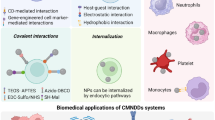Abstract
Purpose
Ultrasound-induced cavitation facilitates cellular uptake of drugs via increased membrane permeability. Here, the purpose was to evaluate the duration of enhanced membrane permeability following ultrasound treatment in cell culture.
Procedures
Optical chromophores with fluorescence intensity increasing 100–1,000-fold upon intercalation with nucleic acids served as smart agents for reporting cellular uptake. Opticell chambers with a monolayer of C6 cells were subjected to ultrasound in the presence of microbubbles followed by varying delays between 0 and 24 h before addition of Sytox Green optical contrast agent. Micro- and macroscopic fluorescence were used for qualitative and quantitative analysis.
Results
Up to 25% of viable cells showed uptake of contrast agent with a half time of 8 h, with cellular uptake persisting even at 24 h. Only cells exposed to ultrasound showed the effect.
Conclusion
The temporal window of increased membrane permeability is much longer in these studies than previously suggested. This may have important repercussions for in vivo studies in which membrane permeability may be temporally separated from drug delivery.







Similar content being viewed by others
References
Juillerat-Jeanneret L (2008) The targeted delivery of cancer drugs across the blood–brain barrier: chemical modifications of drugs or drug-nanoparticles? Drug Discov Today 13(23–24):1099–1106
Simone E, Ding BS, Muzykantov V (2009) Targeted delivery of therapeutics to endothelium. Cell Tissue Res 335(1):283–300
Hernot S, Klibanov AL (2008) Microbubbles in ultrasound-triggered drug and gene delivery. Adv Drug Deliv Rev 60(10):1153–1166
Deckers R, Rome C, Moonen CT (2008) The role of ultrasound and magnetic resonance in local drug delivery. J Magn Reson Imaging 27(2):400–409
Larkin JO, Casey GD, Tangney M et al (2008) Effective tumor treatment using optimized ultrasound-mediated delivery of bleomycin. Ultrasound Med Biol 34(3):406–413
Yuh EL, Shulman SG, Mehta SA et al (2005) Delivery of systemic chemotherapeutic agent to tumors by using focused ultrasound: study in a murine model. Radiology 234(2):431–437
Treat LH, McDannold N, Vykhodtseva N et al (2007) Targeted delivery of doxorubicin to the rat brain at therapeutic levels using MRI-guided focused ultrasound. Int J Cancer 121(4):901–907
Unger EC, McCreery TP, Sweitzer RH et al (1998) Acoustically active lipospheres containing paclitaxel: a new therapeutic ultrasound contrast agent. Invest Radiol 33(12):886–892
Tartis MS, McCallan J, Lum AF et al (2006) Therapeutic effects of paclitaxel-containing ultrasound contrast agents. Ultrasound Med Biol 32(11):1771–1780
Rapoport NY, Kennedy AM, Shea JE et al (2009) Controlled and targeted tumor chemotherapy by ultrasound-activated nanoemulsions/microbubbles. J Control Release 138(3):268–276
Taniyama Y, Tachibana K, Hiraoka K et al (2002) Development of safe and efficient novel nonviral gene transfer using ultrasound: enhancement of transfection efficiency of naked plasmid DNA in skeletal muscle. Gene Ther 9(6):372–380
Dittmar KM, Xie J, Hunter F et al (2005) Pulsed high-intensity focused ultrasound enhances systemic administration of naked DNA in squamous cell carcinoma model: initial experience. Radiology 235(2):541–546
Rome C, Deckers R, Moonen CT (2008) The use of ultrasound in transfection and transgene expression. Handb Exp Pharmacol 185(2):225–243
Kinoshita M, Hynynen K (2005) A novel method for the intracellular delivery of siRNA using microbubble-enhanced focused ultrasound. Biochem Biophys Res Commun 335(2):393–399
Saito M, Mazda O, Takahashi KA et al (2007) Sonoporation mediated transduction of pDNA/siRNA into joint synovium in vivo. J Orthop Res 25(10):1308–1316
Mehier-Humbert S, Yan F, Frinking P et al (2007) Ultrasound-mediated gene delivery: influence of contrast agent on transfection. Bioconjug Chem 18(3):652–662
van Wamel A, Kooiman K, Harteveld M et al (2006) Vibrating microbubbles poking individual cells: drug transfer into cells via sonoporation. J Control Release 112(2):149–155
Schlicher RK, Radhakrishna H, Tolentino TP et al (2006) Mechanism of intracellular delivery by acoustic cavitation. Ultrasound Med Biol 32(6):915–924
O’Neill BE, Vo H, Angstadt M et al (2009) Pulsed high intensity focused ultrasound mediated nanoparticle delivery: mechanisms and efficacy in murine muscle. Ultrasound Med Biol 35(3):416–424
Hancock HA, Smith LH, Cuesta J et al (2009) Investigations into pulsed high-intensity focused ultrasound-enhanced delivery: preliminary evidence for a novel mechanism. Ultrasound Med Biol 35(10):1722–1736
Hallow DM, Mahajan AD, Prausnitz MR (2007) Ultrasonically targeted delivery into endothelial and smooth muscle cells in ex vivo arteries. J Control Release 118(3):285–293
Greis C (2004) Technology overview: SonoVue (Bracco, Milan). Eur Radiol 14(Suppl 8):P11–P15
Lepetit-Coiffé MYA, Lourenco de Oliveira P et al (2009) Correlation of ultrasound-mediated drug delivery with acoustical properties of the transducer by macroscopic fluorescence imaging. In: ISTU. Aix on Provence, France
Lionetti V, Fittipaldi A, Agostini S et al (2009) Enhanced caveolae-mediated endocytosis by diagnostic ultrasound in vitro. Ultrasound Med Biol 35(1):136–143
Meijering BD, Juffermans LJ, van Wamel A et al (2009) Ultrasound and microbubble-targeted delivery of macromolecules is regulated by induction of endocytosis and pore formation. Circ Res 104(5):679–687
Acknowledgment
This study was supported by EC-project FP7-ICT-2007-1-213706 SonoDrugs and Foundation InNaBioSanté-project ULTRAFITT. The authors thank Franck Couillaud for the discussions and Roel Deckers and Sander Allon for the preliminary experiments with Opticell and intercalating dyes. Microscopy was performed in the Bordeaux Imaging Center of the Neurosciences Institute of the University of Bordeaux II; the help of Philippe Legros and Christel Poujol is acknowledged.
Author information
Authors and Affiliations
Corresponding author
Rights and permissions
About this article
Cite this article
Yudina, A., Lepetit-Coiffé, M. & Moonen, C.T.W. Evaluation of the Temporal Window for Drug Delivery Following Ultrasound-Mediated Membrane Permeability Enhancement. Mol Imaging Biol 13, 239–249 (2011). https://doi.org/10.1007/s11307-010-0346-5
Published:
Issue Date:
DOI: https://doi.org/10.1007/s11307-010-0346-5




